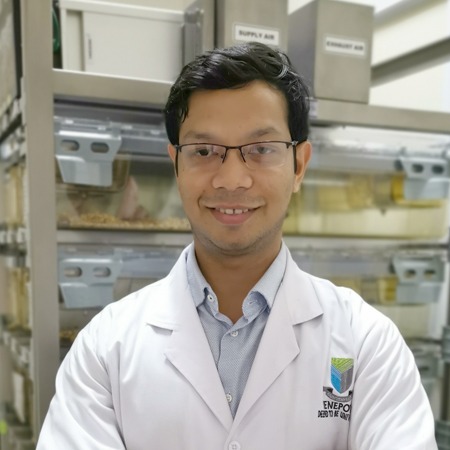
Debajit Chaudhury
Research Associate
-
Radiation Biology
-
MSc (Area): (Medical) Biochemistry
-
chaudhury.debajit@gmail.com, debajit@yenepoya.edu.in
Debajit has completed his Master’s degree in Medical Biochemistry (2012-2015) from Kasturba Medical College, Manipal Academy of Higher Education, Mangaluru, India. In his Master’s thesis, he had worked on a project entitled “Study of chronic effects of varying dosage of X-ray on DNA damage, hepatotoxicity and nephrotoxicity in wistar albino rats”. He joined Yenepoya Research Centre in July, 2017 and he is working on the effect of thoron inhalation in in vivo conditions. Previous to his joining here at YRC as a Ph.D. student, he had gained experience as a Medical Biochemist while working at a NABH accredited laboratory. He had also has gained teaching experience while employed as a lecturer of Biochemistry at Shri Shankaracharya Institute of Medical Sciences. His expertise lies in diagnostic biochemistry and in molecular biology techniques and enzyme assay.
Experience
-
Ph.D. Research scholar (July,2017- March 2023) – Yenepoya Research Centre, Mangaluru
- Tutor/ Demonstrator (2016-2017) – Shri Shankaracharya Institute of Medical Sciences
- Medical Biochemist (Feb, 2016-June, 2016) – Doyen Diagnostics and Research Foundation (NABH accredited; ISO 9001:2008), Patna
- Research Interest/Area: Radiation biology, Oxidative stress, Enzyme kinetics, Cell and Molecular biology, Inborn Errors of Metabolism
Awards/Honors
- Won the best poster award for the scientific paper titled “Radioactive dose deposition upon thoron inhalation and subsequent biological alterations in lung tissues” at the 47th National Conference of ACBICON, December 2021
- Won the “SECOND PRIZE for the scientific paper titled “Modulatory effect of whey preparation on liver thiols of rats exposed to etoposide” at the 4th AMBI-Chhattisgarh State Chapter, January 2017
- Won the best poster award for the scientific paper titled “Modulatory effect of whey preparation on brain thiols of rats exposed to etoposide” at the 41st National Conference of ACBICON, December 2014
Research Interest/Area
Radiation Biology, enzyme kinetics, cell and molecular biology, inborn errors of metabolism
Research
Monazite sand prevalent in coastal South India and some coastal regions of Orissa is naturally occurring sand that contains about 90% of 232Th. It is a major contributor to environmental and human radiation hazard due to its decay into daughter progenies. Radiation exposure to humans in these areas indicated an exposure ranging from 2mGy/year to 20mGy/year (Nair et al. 2005). Although 232Th is an α emitter, it has β and γ components along the decay chain. There are no controlled studies of the effect of 232Th on biological systems. So, we propose to investigate the effects of 232Th exposure primarily in the respiratory system, and other sensitive organs in a BALB/c mice model.
Publication
-
Bose B‡, Kapoor S‡, Sen U‡, As MN, Chaudhury D, Shenoy S. Assessment of Oxidative Damage in the Primary Mouse Ocular Surface Cells/Stem Cells in Response to Ultraviolet-C (UV-C) Damage. Journal of visualized experiments: JoVE. 2020 Feb 15(156). ‡Equally contributing first authors
-
Sen U, Chaudhury D, Shenoy P. S, Bose B. Differential sensitivities of triple‐negative breast cancer stem cell towards various doses of vitamin C: An insight into the internal antioxidant systems. J Cell Biochem, Wiley.2020;1–18. (IF 4.2)
- Chaudhury D, Sen U, Bhat NN, Sahoo BK, Shenoy P S, Bose B. Lung damage by thoron progenies versus possible damage redemption by lung stem cells: a perspective. International Journal of Radiation Biology. 2020 Sep 7; 1-36.
- Bose B, Kapoor S, Sen U, Nihad AS M, Chaudhury D, Shenoy P S. Assessment of Oxidative Damage in the Primary Mouse Ocular Surface Cells/Stem Cells in Response to Ultraviolet-C (UV-C) Damage. Journal of Visualized Experiments. 2020 Feb 15 (156).
- Reshma K., Chaudhury D, Sudha K, Chiranth, Rahul, Charu Y. Chronic effects of ionising radiation induced renal damage in albino Wistar rats. Biomedicine: 2020; 40(1): 51- 54.
- Yadav C, Srikantiah RM, Manjrekar P, Shenoy MT, Chaudhury D. Assessment of Mineral Pathophysiology in Patients with Diabetic Foot Ulcer. Biological trace element research. 2019 Aug 21:1-7.
- Debajit C, Reshma K, Sudha K, Yadav C, Rai R. Study of chronic effects of varying dosage of X-rays on hepatotoxicity in wistar albino rats. Asian Journal of Pharmaceutical and Clinical Research. 2018 Feb 1;11(2):293-6.
